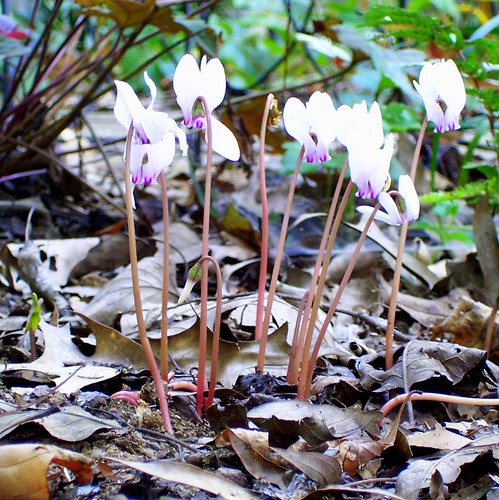Last year I wrote a little about the problem of the autumn garden. As I noted then, for many inexperienced gardeners, the sad state of the garden in autumn is due to lack of planning. I no longer qualify as a novice gardener, and I do plan, really, but having a plan and achieving success are two different things. Gardening, as I have also written before, is mostly about optimism in the face of adversity, paired with a willingness to get dirty.
Last year, I made a conscious effort to plant more late summer- and autumn-blooming plants, and more plants with interesting foliage. Ferns, for example. Ferns are lovely. They have interesting colours and textures. They're well-suited to woodland gardens like mine. There are many beautiful ferns native to the eastern woodlands, and there are gorgeous exotics like the Japanese painted fern.
I planted some ferns, therefore, and some Japanese anemones, and a few corms of the tiny hardy cyclamens I like. I planted them last autumn, according to all the best thinking on perennial gardening, and then waited, with hope, to see would happen.
What happened was we had one of the hottest, driest summers on record. None of the ferns or anemones died (for which I can probably thank the careful autumn planting) but they did go dormant for several weeks during the hottest, driest part of the summer. They have started throwing up some leaves now as cooler weather arrives and we've had some rains, but in terms of providing interesting things to look at, well. They're not much.
Thank heaven for the little cyclamens.

I had forgotten about them, to be honest. I tend to get sticker shock from the price of the corms -- they cost anywhere from $10 to $15 for a packet of three -- so I had only planted a few, and those had not bothered to throw up any leaves.
The leaves are at least half their charm: leathery, heart-shaped, delicately marbled. Their best use is planted around the feet of a tall shrub or small decidous tree where nothing else competes with them and you can admire them all winter. I set my corms at the base of a crape myrtle where they get the light shade and leaf litter they prefer.
But they threw no leaves of their own last winter. This wouldn't have been the first time I'd buried $10-$15 in the ground and never seen it again, so I sighed, wrote them off as a loss, and forgot about them.
Then, in the last week of August, the first tentative bloom stalks appeared. They kept appearing, despite Duke's best efforts to stomp on them, and now there are two fine little clusters of pale pink blossoms, each arising from a single corm. C. hederifolium is well known for spreading easily by seed, so I am hopeful that in a few years I'll have a lovely carpet of pink flowers each September, and all the beautiful leaves through the winter.
Jan Owen

Hurray! Gardening is entirely new to me but I am already becoming adept at burying money in the garden never to be seen again. But I have cyclamen (bought in small pots, not grown from scratch) braving it out under a young olive tree. Fingers crossed they survive my ministrations. C.x
ReplyDelete